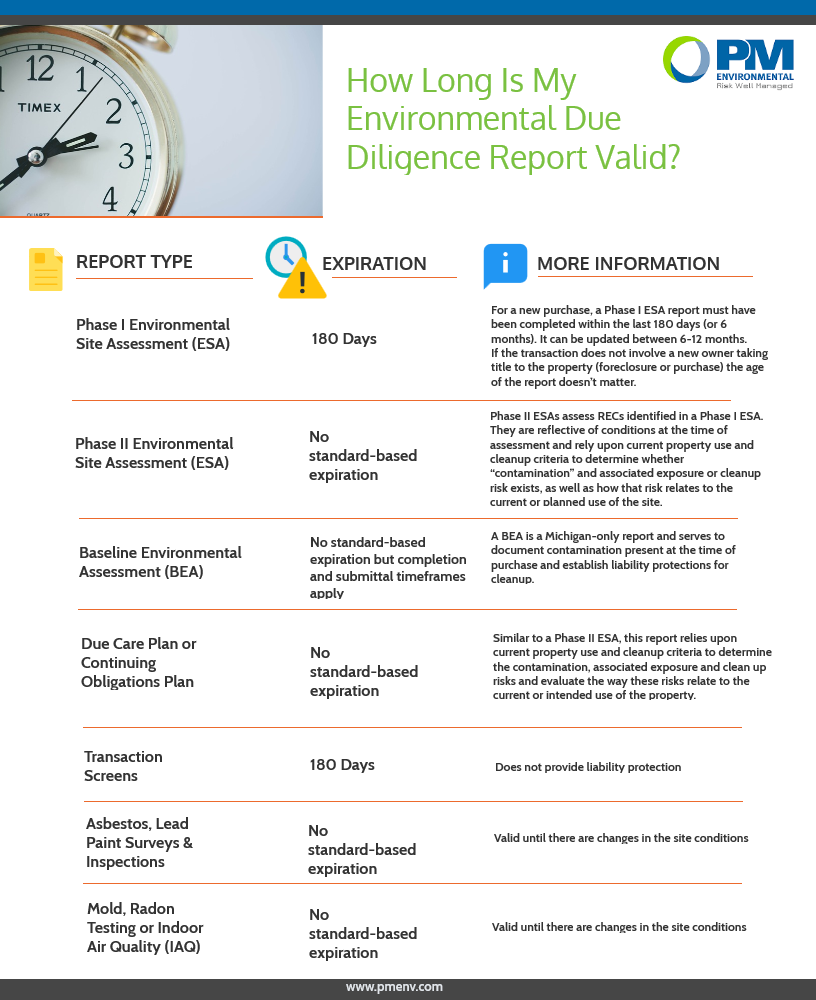How long is my Phase I ESA, Transaction Screen or BEA good for?
In an ideal world, environmental due diligence reports would be like honey or soy sauce and last for many years. Since shelf-life varies on reports, you need to be aware of the limitations and risks of using old or outdated information for current real estate transactions.
Below, we outline the validity of many common reports and considerations to keeping them useful.
Click on the image to download PDF.

Phase I Environmental Site Assessment (ESA)
180 days – For a new purchase, the report must have been within the last 180 days (or 6 months). It can be updated between 6-12 months.
If the transaction does not involve a new owner taking title to the property (foreclosure or purchase) the age of the report doesn’t matter.
So, if you get a Phase I ESA done for the purchase of a property, and close within 180 days, you don’t have to keep updating it every six months while you own the property – you only need it done once for All Appropriate Inquiry (AAI) protection.
Phase II ESA
No standard-based expiration – Phase II ESAs assess RECs identified in a Phase I ESA at a moment in time. They are reflective of conditions at the time of assessment and rely upon current property use and cleanup criteria to determine whether “contamination” and associated exposure or cleanup risk exists, as well as how that risk relates to the current or planned use of the site.
Therefore, if site use or conditions change such that a new release happens, or if additional RECs are identified via a subsequent Phase I ESA, a previously “clean” Phase II ESA will no longer be relevant. Similarly if cleanup criteria change, the conclusions of an old Phase II ESA may not be valid. There are many other scenarios as well.
Baseline Environmental Assessment (BEA)
No standard-based expiration; however, statute requires completion and/or submittal within specified timeframes. A BEA is a Michigan-only report and serves to document contamination present at the time of purchase and establish liability protections for cleanup based upon what was documented (i.e. the “facility” or “Property” status of a parcel of land). The liability protections don’t expire either, but are not transferrable. A BEA is required to be completed prior to or within 45 days of a property transfer (purchase, foreclosure, etc.) and must be submitted within 6 months of that property transfer. They also don’t shield an owner/operator from third party claims or apply to contamination regulated by federal statute.
The liability protections rely upon the owner/operator practicing “due care” to prevent unacceptable human exposures and prevent exacerbation of existing contamination. They do not apply to new releases (i.e. additive contamination post-purchase or initial operation), nor to costs associated with contamination exacerbated via the actions of the owner/operator.
If cleanup occurs to below an unrestricted Residential standard such that the site obtains No Further Action or regulatory Closure is granted, the BEA liability protections don’t formally expire, they just become irrelevant because the Facility or Property status of the parcel that they were once based on is no longer applicable.
Due Care Plan / Continuing Obligations Plan
Similar to a Phase II ESA, this report relies upon current property use and cleanup criteria to determine the contamination, associated exposure and clean up risks and evaluate the way these risks relate to the current or intended use of the property. The results will ultimately determine what actions must be taken to prevent exposure, prevent exacerbation, and operate the property in a manner that is consistent with the intended use. If submitted for regulatory review, specific statutory timeframes may apply.
These are intended to be “living documents” because once the use, contamination/concentrations, and/or cleanup criteria change, the Due Care Plan/Continuing Obligations Plan needs to be updated accordingly to ensure that the use of the property is congruent with and protective of current conditions.
Transaction screens
Also 180 days. Transaction Screens do not provide any liability protection.
Industrial Hygiene Reports
Asbestos and lead paint surveys/inspections are valid until there are changes in the site conditions. No expiration date.
Other types of reports, such as mold assessments, radon testing or IAQ, are really a “snapshot in time” and describe site conditions as identified at the time of assessment, therefore, site conditions may need to reassessed as-needed if the underlying causes are not remediated.
Have questions? Call us at 800.313.2966 or Contact us
Related Articles:
Publication Details
Date
June 28, 2017



